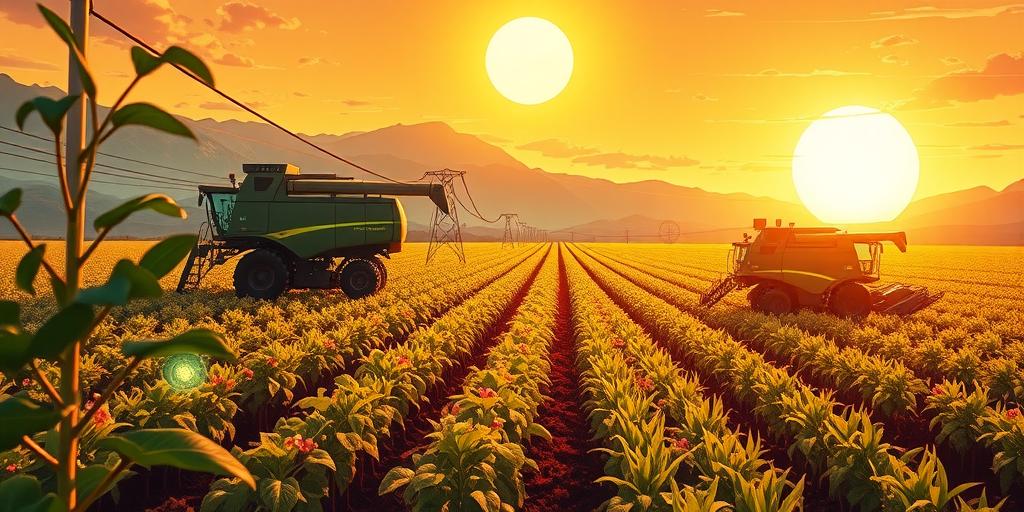Prepare to be amazed! The Internet of Things (IoT) is quietly revolutionizing the way we grow food, promising a future of hyper-efficient farms and a more sustainable food supply. Forget the dusty image of farming – this is a high-tech world of data-driven decisions, precision irrigation, and robotic harvesters. Get ready to dive into the inspiring story of IoT in modern agriculture and discover how this transformative technology is shaping the future of food production.
The Rise of Smart Farming: How IoT is Transforming Agriculture
The agricultural landscape is undergoing a massive transformation, driven by the rapid adoption of IoT technologies. These aren’t your grandfather’s farming tools; we’re talking about sophisticated sensors, powerful data analytics, and smart irrigation systems all working in harmony to maximize efficiency and yield. Smart farming, enabled by IoT, is no longer a futuristic fantasy – it’s the present reality for many progressive farmers.
Precision Agriculture: Data-Driven Decisions for Optimal Yields
Imagine a farm where every plant receives precisely the right amount of water, fertilizer, and pesticides. This isn’t science fiction; it’s the promise of precision agriculture. IoT sensors continuously monitor soil conditions, plant health, and weather patterns, providing farmers with real-time data to inform their decisions. This level of precision reduces waste, improves yields, and minimizes the environmental impact of farming operations.
Smart Irrigation: Conserving Water and Optimizing Resource Use
Water scarcity is a growing concern worldwide, making efficient water management crucial for sustainable agriculture. IoT-enabled smart irrigation systems use sensors to monitor soil moisture levels and adjust watering schedules accordingly. This prevents overwatering, conserves precious water resources, and ensures that plants receive the optimal amount of hydration. This is crucial in arid and semi-arid regions facing increasing water stress, thus helping to ensure food security.
Remote Monitoring and Automation: Enhancing Efficiency and Productivity
IoT allows farmers to remotely monitor their operations, no matter where they are. Sensors transmit data on various parameters, and automated systems adjust irrigation, fertilization, and other aspects according to pre-set parameters or real-time conditions. This enhances efficiency, reduces labor costs, and allows farmers to make timely decisions to address any issues, even if they are not physically present on the farm.
The Benefits of IoT in Agriculture: A Sustainable Future
The integration of IoT in agriculture offers a wide array of advantages, extending beyond mere increased efficiency. The benefits ripple across various aspects of the food production chain, paving the way for a more sustainable and secure future for our global food systems. Let’s explore some of these key benefits:
Increased Yields and Reduced Costs: Optimizing Resource Allocation
By providing real-time insights into crop health and environmental conditions, IoT helps farmers optimize resource allocation. This means reduced waste of water, fertilizers, and pesticides, leading to both cost savings and improved yields. The bottom line? More food, grown more efficiently and sustainably.
Improved Crop Quality and Reduced Waste: Precision Farming Techniques
IoT-enabled precision farming techniques ensure that crops receive the exact amount of resources they need, resulting in healthier plants and higher-quality produce. Reduced waste and improved quality contribute to higher profitability for farmers and a more efficient food supply chain. This leads to less spoilage and ensures consumers get the best possible products.
Enhanced Sustainability and Environmental Protection: Minimizing Environmental Impact
By optimizing resource use and reducing waste, IoT-enabled agriculture significantly minimizes the environmental impact of farming. This contributes to sustainable agriculture practices, protecting our natural resources, and mitigating the effects of climate change. This is vital for a greener future, reducing carbon footprints and conserving biodiversity.
The Future of Farming: IoT and Beyond
The future of agriculture is inextricably linked to the continued development and adoption of IoT technologies. As these technologies become more sophisticated and affordable, their applications in farming will only expand. Imagine a future where: autonomous vehicles manage planting and harvesting; AI algorithms predict and prevent crop diseases; and blockchain technology ensures food traceability and transparency. The possibilities are vast and incredibly promising. The future of food is digital, data-driven, and unbelievably efficient.
AI and Machine Learning Integration: Predictive Analytics and Automation
The integration of AI and machine learning with IoT devices is creating powerful predictive analytics capabilities. Farmers can anticipate potential problems, such as pest infestations or diseases, and take proactive measures to mitigate them. This leads to reduced crop losses and even better yield optimization, further enhancing farm efficiency. This combination of IoT and AI represents a leap forward in farming technology.
Blockchain Technology and Food Traceability: Ensuring Transparency and Safety
Blockchain technology, when combined with IoT, provides unparalleled transparency in the food supply chain. Every step of the process, from farm to table, can be tracked and verified, ensuring food safety and allowing consumers to make informed purchasing decisions. This traceability is crucial in a globalized food system and helps build greater consumer trust.
Embrace the future of food! Get involved in the exciting world of IoT in agriculture and help build a more sustainable and efficient food system. Together, we can ensure food security for generations to come.




